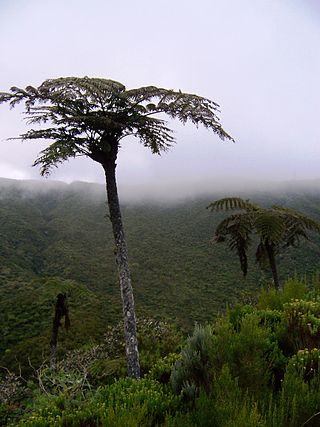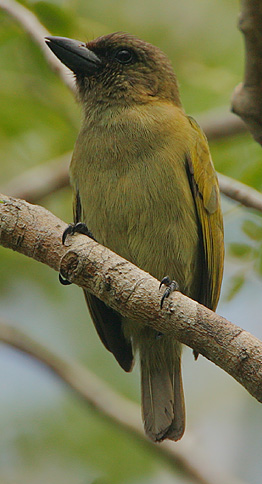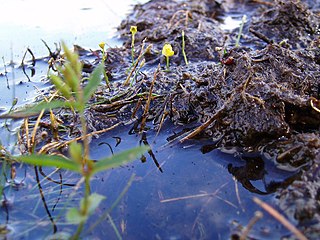The gymnosphaerids are a small group of heliozoan protists found in marine environments. They tend to be roughly spherical with radially directed axopods, supported by microtubules in a triangular-hexagonal array arising from an amorphous central granule.

The scarlet tanager is a medium-sized American songbird. Until recently, it was placed in the tanager family (Thraupidae), but it and other members of its genus are now classified as belonging to the cardinal family (Cardinalidae). The species' plumage and vocalizations are similar to other members of the cardinal family, although the Piranga species lacks the thick conical bill that many cardinals possess. The species resides in thick deciduous woodlands and suburbs.

Mountain coatis are two species of procyonid mammals from the genus Nasuella. Unlike the larger coatis from the genus Nasua, mountain coatis only weigh 1.0–1.5 kilograms (2.2–3.3 lb) and are endemic to the north Andean highlands in South America.

The olive ridley sea turtle, also known commonly as the Pacific ridley sea turtle, is a species of turtle in the family Cheloniidae. The species is the second-smallest and most abundant of all sea turtles found in the world. L. olivacea is found in warm and tropical waters, primarily in the Pacific and Indian Oceans, but also in the warm waters of the Atlantic Ocean.

The Cyatheaceae are a family of ferns, the scaly tree ferns, one of eight families in the order Cyatheales in the Pteridophyte Phylogeny Group classification of 2016. Alternatively, the family may defined much more broadly as the only family in the Cyatheales, with the PPG I family treated as the subfamily Cyatheoideae. The narrower circumscription is used in this article.

The western mountain coati or western dwarf coati is a small procyonid, found in cloud forest and páramo at altitudes of 1,300–4,250 metres (4,270–13,940 ft) in the Andes of Colombia and Ecuador. A population discovered in the Apurímac–Cuzco region of southern Peru has tentatively been identified as the western mountain coati, but may represent an undescribed taxon.

Gastrophryne olivacea, the Great Plains narrow-mouthed toad or western narrow-mouthed toad, is a species of microhylid frog found throughout much of the south-central United States from Nebraska south through Texas, and into northern Mexico. Though not a true toad, it is often referred to as such because it is terrestrial.
Gymnosphaera acrostichoides is a species of tree fern found in forests of eastern Indonesia and Papua New Guinea.
Gymnosphaera commutata is a Malesian species of tree fern found in wet and swampy forests.
Gymnosphaera glabra, synonyms Alsophila glabra and Cyathea glabra, is a species of tree fern native to Borneo, western Java, Sumatra, the Lesser Sunda Islands, Sulawesi, and the Malay Peninsula, where it grows in lowland swamp forest and montane forest at an elevation of up to 1500 m. The trunk of this plant is erect and 2–4 m tall. Fronds are bi- or tripinnate and 1–2 m in length. Characteristically of this species, the lowest pinnae may be significantly reduced. The stipe is very dark and bears basal scales. These scales are dark, glossy and have a paler margin and fragile edges. Sori are produced in groups of one to three on fertile pinnule veins. They lack indusia.
Gymnosphaera denticulata, synonyms Alsophila acaulis, Alsophila denticulata and Cyathea hancockii, is a species of tree fern native to Japan, the Ryukyu Islands, Taiwan, southern China, Hong Kong, and Hainan. It grows in forest, on stream banks, and in forest margins at an elevation of about 600 m or higher. The specific epithet hancockii commemorates William Hancock (1847-1914), who collected numerous plants in Japan, China and Southeast Asia.
Gymnosphaera hornei is a species of tree fern in the Cyatheaceae family.

Alsophila is a genus of tree ferns in the family Cyatheaceae. It has also been considered to be a section in the subgenus Cyathea of the genus Cyathea.

Gymnosphaera podophylla, synonyms Alsophila podophylla and Cyathea podophylla, is a widespread species of tree fern native to southern China, Hainan, Taiwan, Vietnam, Laos, Myanmar, Thailand, Cambodia, the Ryukyu Islands, and Japan. It grows in forest by streams and in ravines at elevations of 600–1000 m.

The olive ibis is a species of ibis native to dense tropical forests in central Africa. Between 65 and 75 cm in length, it is a small ibis with olive plumage displaying an iridescent sheen. Four subspecies are recognized.

The olive sunbird is a species of sunbird found in a large part of Africa south of the Sahel. It prefers forested regions, and is absent from drier, more open regions such as the Horn of Africa and most of south-central and south-western Africa. It is sometimes placed in the genus Nectarinia.

The green barbet is a species of bird in the Lybiidae family. It is found in Kenya, Tanzania, Malawi, Mozambique and South Africa. It occurs in forests from sea level to 1,800 metres (5,900 ft). Its isolated populations are vulnerable to forest clearing.

The brown-tailed mongoose, brown-tailed vontsira, Malagasy brown-tailed mongoose, or salano is a species of mammal in the family Eupleridae. It is endemic to Madagascar. Its natural habitat is moist lowland tropical forest. It is threatened by habitat loss.

Utricularia olivacea, the piedmont bladderwort, is a very small, annual suspended aquatic carnivorous plant that belongs to the genus Utricularia. Utricularia olivacea is native to Central America, South America, the West Indies, and the eastern United States.

Priyambada Mohanty Hejmadi is a scientist, academician and an Indian classical dancer of Odissi, art writer, and a biologist.. Born on 18 November 1939, she secured a master's degree and subsequently, obtained a doctoral degree in zoology from the University of Michigan, Ann Arbor, USA. She also mastered in Odissi from an early age under Ban Bihari Maiti and her Odissi performance at the Inter-University Youth Festival in New Delhi in 1954 is reported to have helped the dance form to gain international attention through Charles Fabri, the renowned art critic from Hungary, who was present at the function.












